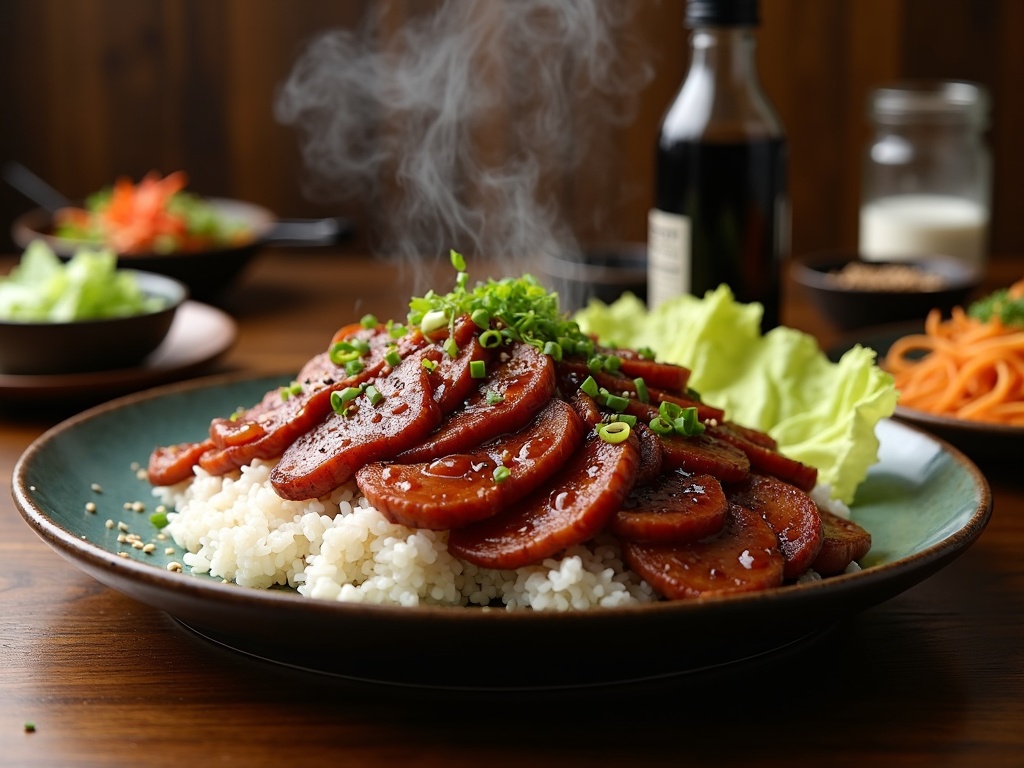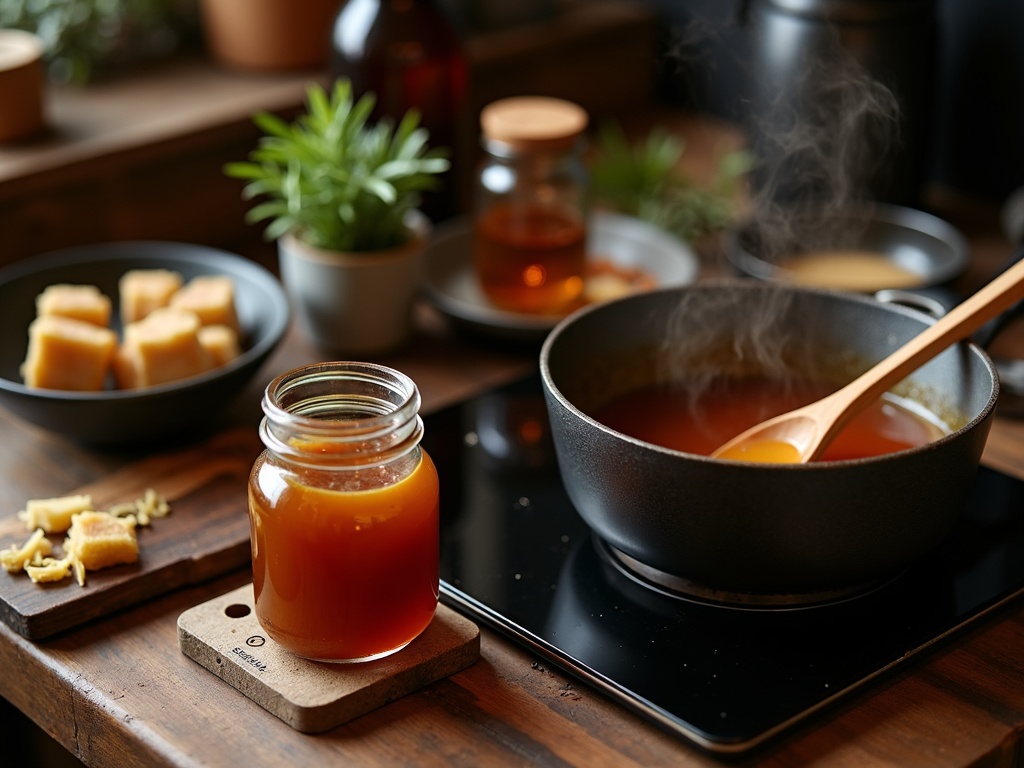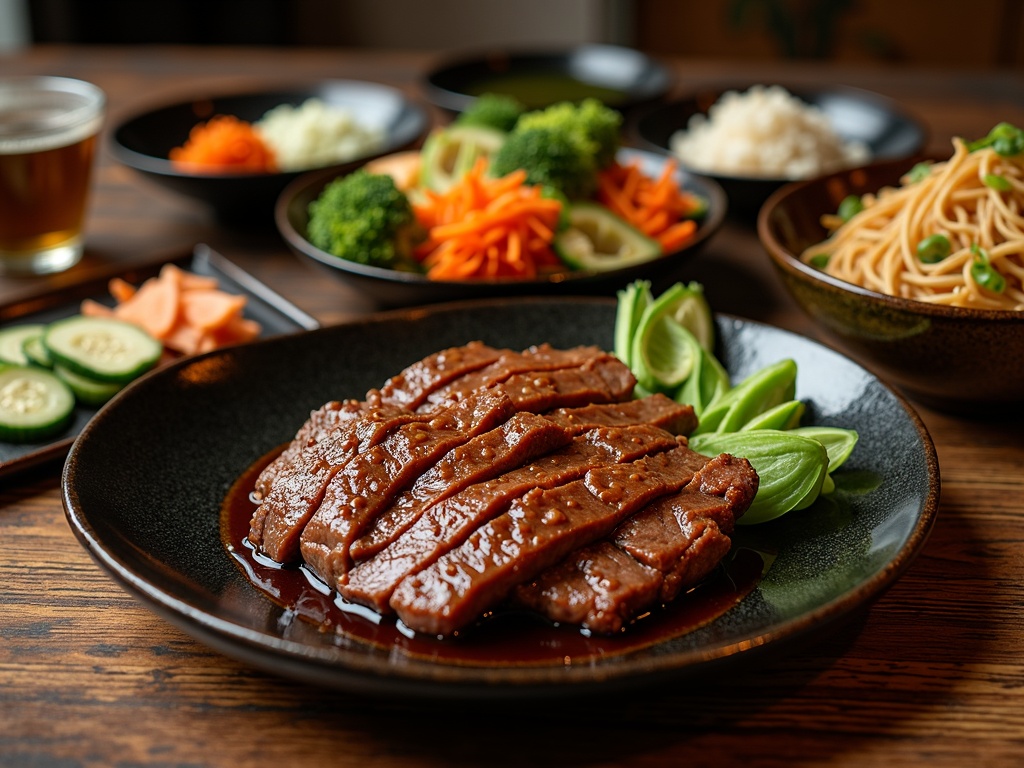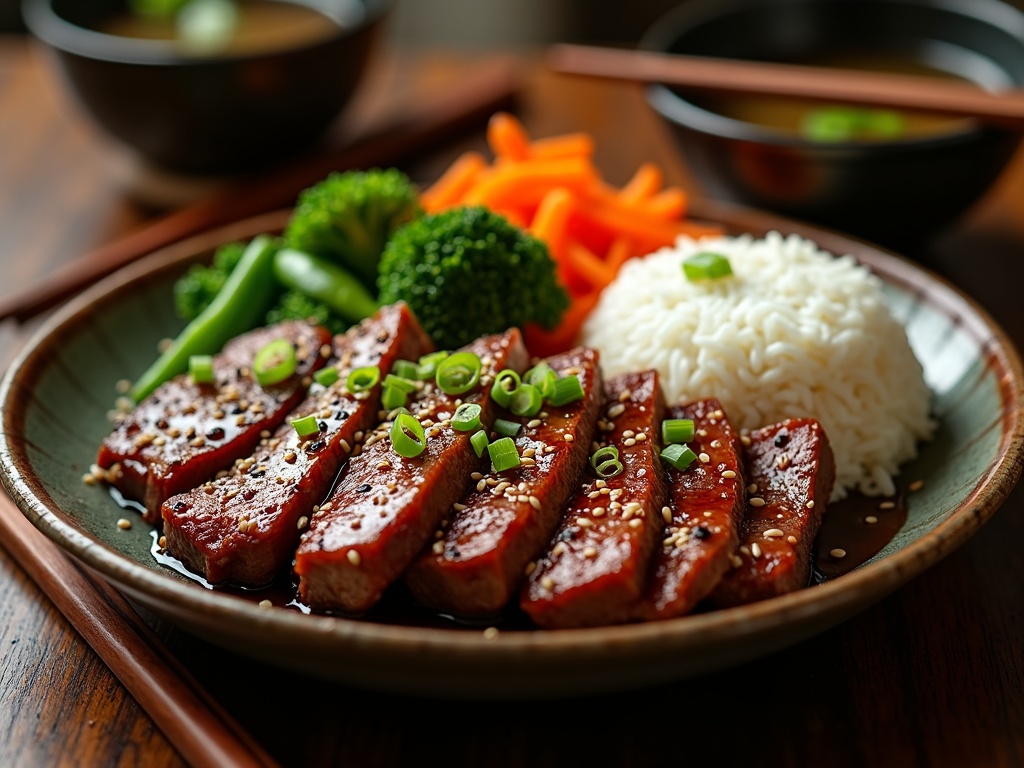Beef teriyaki combines thinly sliced beef with a sweet and savory glaze that creates a perfect balance of umami flavors, resulting in a dish that’s both comforting and distinctive. This Japanese culinary export has grown from its 17th-century origins into a globally beloved meal that highlights the natural flavors of beef while offering versatility, accessibility, and a satisfying depth of flavor.
Find In This Article
Key Takeaways
- Teriyaki sauce traditionally combines soy sauce, mirin, sugar, and sake to create the signature glossy coating that caramelizes during cooking.
- The best cuts for beef teriyaki include sirloin, ribeye, and flank steak, which should always be sliced thinly against the grain for maximum tenderness.
- Proper marinade technique is essential, with 30 minutes minimum but 2–4 hours ideal for deeper flavor penetration.
- Temperature control during cooking is crucial—start with high heat for a good sear, then reduce to allow the sauce to properly thicken and glaze the beef.
- Healthier versions can be created by using lower-sodium soy sauce, natural sweeteners, leaner cuts of beef, and adding plenty of vegetables for a balanced meal.
The Perfect Sweet and Savory Combination
Teriyaki has secured its place as one of the most recognizable and beloved Japanese culinary exports, offering a delicious balance of sweet and savory flavors that’s hard to resist. The name itself reveals its cooking method – “teri” refers to the shine or luster created by the sauce, while “yaki” means grilled or broiled. This technique creates the signature glossy appearance that makes beef teriyaki dishes instantly recognizable.
Origins and Evolution of Teriyaki
Teriyaki cooking techniques date back to 17th century Japan, though the sauce we know today has evolved significantly. Traditional Japanese teriyaki was simply a mixture of soy sauce, mirin (rice wine), and sugar used to glaze grilled fish. The preparation focused on highlighting the natural flavors of the protein rather than overwhelming it.
When Japanese immigrants arrived in Hawaii in the early 1900s, they adapted their cooking techniques to local ingredients. This cultural fusion gave birth to what many know as modern teriyaki sauce. Pineapple juice became a common addition, contributing both sweetness and tenderizing properties perfect for ground beef recipes and other meat preparations.
By the 1960s, teriyaki had made its way to the American mainland, particularly in Seattle, where it became the foundation for numerous quick-service restaurants. These establishments helped popularize beef teriyaki as we know it today, with its characteristic sweet glaze and tender, flavorful meat.
Global Appeal and Adaptability
I find it fascinating how beef teriyaki has maintained its popularity across cultures for several key reasons:
- Universal Flavor Profile: The combination of sweet and savory elements appeals to taste preferences across different cultures, making it an accessible entry point to Japanese flavors.
- Versatility: Teriyaki sauce pairs wonderfully with various proteins and vegetables, but beef shines particularly bright. The rich, umami flavors of beef complement the sweet-savory teriyaki glaze perfectly, creating a satisfying depth of flavor.
- Easy Preparation: While restaurant-quality beef noodle dishes might seem fancy, teriyaki can be surprisingly simple to make at home with basic pantry ingredients.
- Adaptability: Teriyaki has proven remarkably adaptable to different culinary contexts. You’ll find it featured in everything from classic Japanese preparations to fusion tacos, burgers, and even as a flavoring for potato chips.
- Health Perception: When prepared thoughtfully, teriyaki dishes can offer a balanced meal with protein, vegetables, and carbohydrates. The sauce itself can be adjusted to reduce sugar content while maintaining flavor.
The flexibility of teriyaki sauce has allowed it to evolve beyond traditional applications. Today’s creative cooks incorporate teriyaki into diverse dishes ranging from beef chow mein fusion recipes to meatballs, stir-fries, and even as a glaze for roasted vegetables.
What makes beef teriyaki particularly special is how it showcases the meat. The sugars in the sauce caramelize during cooking, creating a mouthwatering crust on the exterior while the interior remains tender and juicy. This contrast in textures, combined with the flavor interplay between the marinade and beef, creates a dining experience that’s both comforting and exciting.
Whether you’re enjoying a quick beef teriyaki bowl from a food court or preparing an elevated version with premium steak at home, this dish exemplifies how simple ingredients, prepared with care, can create something truly exceptional. The continued popularity of beef teriyaki speaks to its perfect balance of flavors and textures that keeps diners coming back for more.
What Makes This Dish Special
Beef teriyaki stands out in the world of Japanese cuisine thanks to its perfect harmony of flavors and straightforward preparation. The magic happens when tender slices of beef meet a glossy, caramelized sauce that’s both sweet and savory in equal measure.
A Symphony of Flavor and Convenience
The hallmark of exceptional beef teriyaki is the meticulous balance between sweet and umami elements. The teriyaki sauce combines soy sauce’s deep saltiness with the natural sweetness of mirin and sugar, creating a flavor profile that’s instantly recognizable yet never boring. When this sauce reduces and caramelizes on the beef, it creates a glossy coating that’s simply irresistible.
I’ve found that beef teriyaki is also a lifesaver on busy weeknights. Unlike many other beef dishes that require lengthy marinating or slow cooking, a properly prepared beef teriyaki recipe can go from kitchen to table in under 30 minutes. The thin slicing of the beef is key here — it allows for lightning-fast cooking while ensuring tenderness in every bite.
One of my favorite aspects of beef teriyaki is its incredible versatility when it comes to meal planning. You can pair it with various sides to create completely different dining experiences:
- Steamed rice and a simple cucumber salad for a traditional Japanese meal
- Stir-fried vegetables for a complete one-pan dinner
- Noodles like udon or soba for a heartier option similar to beef chow mein
- Wrapped in lettuce leaves for a low-carb alternative
The adaptability doesn’t stop at side dishes. The teriyaki technique works beautifully with different cuts of beef as well. While ribeye or sirloin offer luxurious tenderness, you can also create a delicious ground beef version that’s both economical and family-friendly.
For those looking to experiment further, beef teriyaki can serve as a gateway to other Asian beef dishes. The skills and techniques you’ll learn making it transfer perfectly to creating dishes like Mongolian beef noodles, expanding your culinary repertoire with minimal additional effort.

Everything You Need
I’ve found that successful beef teriyaki starts with gathering the right ingredients. The perfect combination creates that signature sweet-savory glaze that makes this dish so irresistible. Let me break down what you’ll need to create authentic beef teriyaki at home.
The Main Ingredients
The star of beef teriyaki is, of course, the beef itself. I prefer thinly sliced cuts like sirloin or ribeye for their tenderness and ability to quickly absorb the marinade. The thin slicing is crucial—it allows the meat to cook rapidly while soaking up all the delicious flavors. If you’re looking for other beef inspirations, ground beef recipes offer versatile alternatives for weeknight meals.
The teriyaki sauce requires a few essential Japanese ingredients:
- Soy sauce: Provides the salty base and rich umami flavor
- Mirin: A sweet rice wine that adds natural sweetness
- Sake: Japanese rice wine that tenderizes the meat
- Brown sugar: Deepens the flavor and helps create that sticky glaze
- Garlic and ginger: Fresh is best for authentic aromatic notes
For finishing your dish, thinly sliced green onions add a fresh, crisp contrast to the rich teriyaki. I often sprinkle them on just before serving to maintain their bright color and flavor.
Ingredient Quality Matters
I can’t stress enough how important quality ingredients are when making beef teriyaki. Using premium cuts of beef makes a noticeable difference in the final dish. For a similar tender beef experience, you might enjoy beef broccoli which also benefits from high-quality meat.
When selecting soy sauce, I recommend using Japanese-style brands for authentic flavor. The same applies to mirin and sake—while substitutes exist, traditional Japanese varieties yield the most authentic results. If you’re feeling adventurous after mastering teriyaki, Mongolian beef noodles offer another delicious Asian beef preparation to try.
The freshness of garlic and ginger significantly impacts your sauce’s flavor profile. I always peel and mince them just before cooking to capture their aromatic oils at their peak. Those same aromatics also form the flavor base for dishes like beef chow mein, another quick-cooking Asian favorite.
By gathering these quality ingredients before you begin, you’ll set yourself up for beef teriyaki success. The preparation is straightforward, but these carefully selected components make all the difference between an ordinary meal and an extraordinary one.
Creating Your Teriyaki Sauce
The secret to incredible beef teriyaki recipes lies in the sauce. I’ve found that getting the perfect balance of sweet, salty, and umami flavors transforms an ordinary dish into something extraordinary. Let me share how to craft a teriyaki sauce that’ll make your taste buds dance.
Mastering the Perfect Flavor Balance
For authentic teriyaki sauce, I stick to these key ratios:
- 1 part soy sauce (traditional Japanese shoyu works best)
- 1 part mirin (sweet rice wine)
- ½ part sake (Japanese rice wine)
- ¼ to ½ part sugar (brown sugar adds depth)
These proportions create that signature teriyaki flavor that pairs beautifully with beef. For a family meal, I typically use:
- ½ cup soy sauce
- ½ cup mirin
- ¼ cup sake
- 2–3 tablespoons brown sugar
The sweetness level can be adjusted based on your preference, but be careful not to overdo it—the goal is balanced flavor, not candy-like sweetness.
Many home cooks miss adding ginger and garlic, but these ingredients add remarkable depth. I grate about 1 teaspoon of fresh ginger and crush 1–2 garlic cloves into the mixture for an aromatic boost that complements beef dishes perfectly.
Perfecting Consistency and Storage
The right consistency makes all the difference between a sauce that coats your beef teriyaki beautifully and one that’s either too watery or gloppy. After combining your ingredients in a saucepan, bring them to a gentle simmer over medium heat. For a thicker sauce that clings to your beef and vegetables, create a slurry with:
- 1 tablespoon of cornstarch
- 2 tablespoons of cold water
Add this slurry to your simmering sauce and stir continuously for 1–2 minutes until it thickens. The sauce should coat the back of a spoon but still flow smoothly—similar to warm honey.
Homemade teriyaki sauce keeps remarkably well. I store mine in an airtight glass container in the refrigerator, where it stays fresh for up to two weeks. The flavors actually deepen and marry over the first few days, making it even better for your next beef teriyaki meal. For longer storage, freeze portions in ice cube trays, then transfer to freezer bags for quick use in future recipes.
Always let the sauce cool completely before refrigerating to maintain food safety. When you’re ready to use it again, simply reheat gently—overheating can break down the delicate balance of flavors.

Step-by-Step Cooking Guide
The journey to perfectly prepared beef teriyaki starts with understanding each critical step in the process. Getting each stage right ensures your beef will be tender, flavorful, and coated in that signature glossy teriyaki glaze that makes this dish so irresistible.
Marinating for Maximum Flavor
Marinating is the foundation of outstanding beef teriyaki. I always start with thinly sliced beef—either sirloin, flank, or ribeye works beautifully. The thinner the slices, the better the marinade penetrates and the more tender your final dish becomes.
For the marinade, I mix:
- 1/3 cup soy sauce
- 1/4 cup mirin (Japanese sweet rice wine)
- 2 tablespoons brown sugar
- 1 tablespoon freshly grated ginger
- 2 minced garlic cloves
- 1 tablespoon sesame oil
Place your beef slices in a shallow dish or ziplock bag and pour the marinade over them. Make sure each piece is fully coated. For best results, I let the beef marinate for at least 30 minutes, but 2–4 hours in the refrigerator yields even more flavor development. If you’re pressed for time, even 15 minutes will impart some flavor, similar to how I prepare Mongolian beef noodles with their quick marinade.
Cooking Techniques for Perfect Results
Preparing the pan correctly is crucial for beef teriyaki success. I typically use a heavy-bottomed skillet or wok for its heat retention properties. Before adding any ingredients, heat the pan on medium-high until it’s properly hot—you can test this by sprinkling a few drops of water; they should sizzle immediately.
Once the pan is ready, add a tablespoon of neutral oil with a high smoke point like canola or vegetable oil. When the oil shimmers, it’s time to start cooking. I always remove the beef from the marinade, letting excess liquid drip off before placing it in the pan. This prevents steaming and promotes better browning.
Temperature control makes all the difference when cooking beef teriyaki. Start with medium-high heat to get a good sear on the beef, which typically takes about 1–2 minutes per side for thin slices. Don’t overcrowd the pan—cook in batches if necessary. Overcrowding leads to steaming rather than searing, which won’t give you that delicious caramelization that makes beef and broccoli and other stir-fries so flavorful.
The timing for adding the sauce is critical. If you’ve marinated the beef, you’ll want to create a separate sauce for finishing. I typically simmer:
- 1/2 cup soy sauce
- 1/4 cup mirin
- 3 tablespoons sugar
- 1 tablespoon cornstarch (mixed with 2 tablespoons water)
Once the beef is cooked through, add this sauce to the pan and reduce the heat to medium-low. The sauce should thicken within 2–3 minutes, forming that signature glossy teriyaki coating. If making a larger batch like for beef chow mein, you might need to adjust sauce quantities accordingly.
For the final touches, I remove the pan from heat and let it rest for a minute. This allows the sauce to set slightly and adhere better to the beef. Garnish with:
- Toasted sesame seeds
- Thinly sliced green onions
- A sprinkle of red pepper flakes (for color and mild heat)
These finishing elements add texture, freshness, and visual appeal that elevates the dish beyond basic ground beef recipes and into restaurant-quality territory.
Common Mistakes to Avoid
Crafting the perfect beef teriyaki might seem straightforward, but there are several pitfalls that can affect your final dish. I’ve found that even small errors can make the difference between a mediocre meal and a restaurant-quality experience.
Key Teriyaki Troubleshooting
Using the wrong cut of beef is perhaps the most common mistake in beef teriyaki preparation. Tough cuts like chuck or round will never achieve that melt-in-your-mouth texture, no matter how good your sauce is. Instead, opt for cuts with good marbling like ribeye, sirloin, or flank steak. For budget-friendly options similar to what I use in my beef and broccoli recipe, try flank steak sliced against the grain.
Overcooking the meat turns even the best cuts into chewy, unappetizing disasters. Beef teriyaki should be cooked quickly over high heat to develop a caramelized exterior while maintaining a juicy interior. I typically cook thin slices for just 1-2 minutes per side, similar to how I prepare meat for beef chow mein.
The sauce consistency can make or break your dish. Too thin, and it won’t cling to the beef properly; too thick, and it becomes overpowering and gloppy. The perfect teriyaki sauce should coat the back of a spoon but still flow smoothly. If your sauce is too thin, let it reduce longer; if too thick, add a splash of water or broth.
Many home cooks skip the crucial step of letting meat rest before slicing. This matters particularly when cooking larger pieces of beef for teriyaki. After cooking, let the meat rest for 5-10 minutes before cutting. This allows the juices to redistribute throughout the meat rather than running out onto your cutting board. I find this step equally important in my Mongolian beef noodles and other ground beef recipes to maintain maximum flavor.
By avoiding these common mistakes, your beef teriyaki will be tender, flavorful, and balanced – a dish that’ll impress family and friends alike.
Pro Tips for Perfect Results
Want to elevate your beef teriyaki from good to restaurant-quality? The secret lies in a few expert techniques that make all the difference in creating that perfect balance of savory, sweet, and umami flavors.
Mastering the Fundamentals
Selecting the right beef cut is crucial for teriyaki success. I prefer using ribeye, sirloin, or flank steak for their ideal balance of tenderness and flavor. Ribeye offers beautiful marbling that keeps the meat juicy during cooking, while sirloin provides a leaner option that still remains tender. Flank steak works wonderfully for budget-conscious cooks, but requires careful attention to slicing technique to maintain tenderness. When shopping, look for beef with bright red coloring and even marbling throughout.
The way you slice your beef dramatically affects the final dish. For maximum tenderness, always slice against the grain — this cuts through the muscle fibers, resulting in beef that’s easier to chew. I recommend partially freezing the meat for about 15–20 minutes before cutting, which firms it up just enough to make thin, even slices easier to achieve. Aim for slices between ⅛ to ¼ inch thickness for quick cooking and optimal texture in your beef teriyaki.
Ingredient Swaps that Work Wonders
Don’t have all the traditional ingredients? No problem. Here are some practical substitutions that work beautifully:
- Honey or maple syrup can replace mirin for sweetness
- Dry sherry or rice vinegar mixed with sugar can substitute for sake
- Coconut aminos make an excellent soy sauce alternative for gluten-free diets
- Brown sugar can replace white sugar for a deeper molasses flavor
Creating the Perfect Teriyaki Glaze
The signature teriyaki glaze is what sets this dish apart from other ground beef recipes. To achieve that perfect sticky-shiny coating, the key is reduction and patience. Start with a slightly thinner sauce than you want for the final result. After cooking your beef, remove it temporarily and simmer the sauce on medium-low heat, stirring occasionally until it thickens enough to coat the back of a spoon. Return your beef to the pan, tossing gently to coat every piece evenly. The sugar in the sauce will caramelize, creating that beautiful glaze that’s characteristic of great teriyaki dishes.
For added flavor complexity that complements the beef perfectly, try adding grated ginger or garlic to your sauce, similar to the flavor profile in Mongolian beef noodles. A touch of sesame oil at the end adds a nutty depth that elevates the entire dish.
Serving Suggestions
Beef teriyaki makes for a fantastic main dish that shines even brighter with the right accompaniments. I’ve found that pairing this savory-sweet dish with complementary sides enhances the overall dining experience, making it a complete and satisfying meal.
Traditional and Modern Pairings
The classic way to serve beef teriyaki stays true to its Japanese roots. These traditional accompaniments have stood the test of time for good reason:
- Steamed short-grain white rice – The perfect canvas for soaking up that delicious teriyaki sauce
- Steamed vegetables – Broccoli, carrots, and snap peas provide color and nutritional balance
- Miso soup – A light, umami-rich starter that complements the main course
- Pickled ginger or cucumber – Adds a refreshing palate cleanser between bites
- Green tea – The slight bitterness cuts through the sweet teriyaki glaze beautifully
If you’re feeling more adventurous, try these modern twists that work surprisingly well:
- Cauliflower rice – A lighter, low-carb alternative to traditional rice
- Quinoa or brown rice – Adds nutritional value and a nutty flavor profile
- Asian slaw – The crunch and acidity balance the tender, glazed beef
- Garlic noodles – For a heartier meal option similar to beef chow mein
- Avocado slices – The creamy texture contrasts nicely with the teriyaki flavors
For an impressive variation, try serving your beef teriyaki over stir-fried noodles, similar to Mongolian beef noodles but with that distinctive teriyaki flavor profile.
Storage and Reheating Tips
Leftover beef teriyaki can be stored in an airtight container in the refrigerator for up to three days. For best results when reheating, I add a splash of water to prevent the sauce from becoming too thick. Microwave in 30-second intervals or gently reheat in a skillet over medium-low heat.
Creative Leftover Ideas
Leftover beef teriyaki can also be repurposed into delicious next-day meals:
- Teriyaki beef fried rice
- Teriyaki beef sandwiches with Asian slaw
- Rice bowl with a fried egg on top
- Beef and vegetable soup
For a complete meal plan option, beef teriyaki pairs wonderfully with a side of beef and broccoli, giving you a delicious spread of complementary flavors. If you’re looking for more versatile beef dishes to round out your menu, explore these ground beef recipes for additional inspiration.

Making It Healthier
Traditional beef teriyaki delivers incredible flavor but can pack a heavy punch of sodium, sugar, and calories. I’ve discovered several effective ways to create a healthier version without sacrificing that distinctive sweet and savory taste.
Smarter Ingredient Swaps
Reducing sodium is one of the easiest modifications for healthier beef teriyaki. I recommend using low-sodium soy sauce, which typically contains 40–50% less sodium than regular versions. Coconut aminos offer another excellent alternative with approximately 70% less sodium than traditional soy sauce while providing a similar umami flavor profile.
Sugar plays a key role in teriyaki’s distinctive taste, but there are better options than refined white sugar. Here are some healthier sweetener alternatives:
- Honey provides natural sweetness with additional antioxidant properties
- Maple syrup adds complexity while using less overall sweetener
- Monk fruit sweetener offers zero calories while maintaining sweetness
- Coconut sugar contains more nutrients than white sugar with a lower glycemic impact
Vegetables transform beef teriyaki from a meat-heavy dish to a balanced meal. I love adding broccoli florets to beef and broccoli dishes for extra fiber and nutrients. Bell peppers, snap peas, carrots, and mushrooms also complement the flavors perfectly while boosting the nutritional profile.
For those who enjoy noodle-based dishes, I suggest trying Mongolian beef noodles with zucchini or shirataki noodles as lower-carb alternatives to traditional wheat-based options. These substitutions can reduce calories substantially.
Portion control makes a significant difference in the overall healthiness of beef teriyaki. I recommend using a kitchen scale to measure a 3–4 ounce serving of beef per person and balancing it with at least two cups of vegetables. This approach maintains satisfaction while reducing overall calories.
When preparing ground beef recipes, choosing leaner options (90–93% lean) cuts fat content substantially. For sliced beef dishes like beef chow mein, selecting sirloin or tenderloin trimmed of visible fat provides plenty of flavor with less saturated fat.
Cooking methods also impact healthiness. Instead of deep frying, I opt for quick stir-frying with minimal oil in a non-stick pan or using an air fryer. These techniques achieve the same caramelization and texture with significantly less added fat.
By implementing these modifications, you’ll create a beef teriyaki dish that satisfies cravings while supporting your health goals – proving that “healthier” doesn’t mean sacrificing the delicious taste you love.

